Metabolomics of lipids and cellular metabolites to understand the impact of diet on human health
Basically, our research aims to contribute to answering the questions: “How does food affect our health?” or more precisely “What is the healthiest diet for me (in the context of inflammatory diseases)?”
We apply instrumental analytical methods to provide quantitative data about the activity of compounds on the molecular stage. Based on this data we gain unrivaled mechanistical information on the effect of diet on physiology in health and disease.
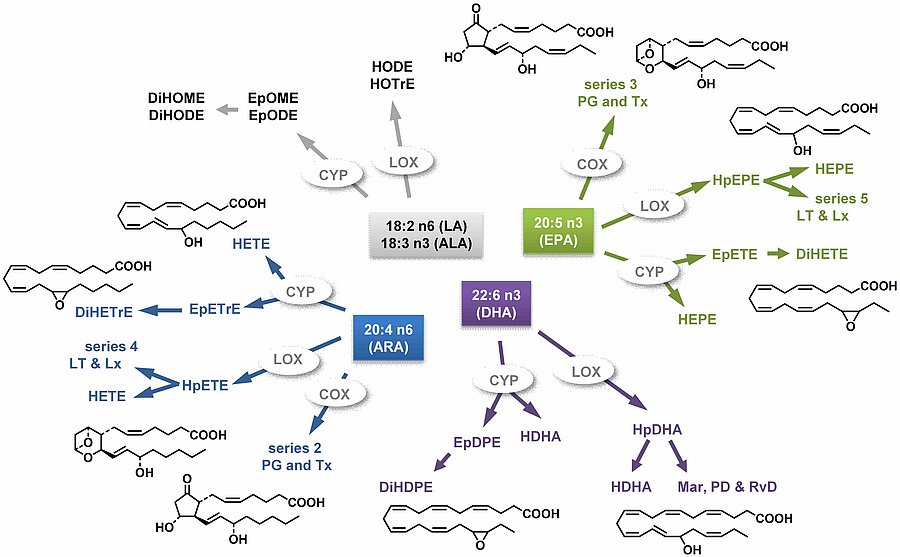
Our major research focus in the past years was set on polyunsaturated fatty acids (PUFA) and their oxidation products, i.e. oxylipins. Eicosanoids and oxylipins from other PUFA are involved in the regulation of various biological functions such as inflammation and vascular tone. They are formed in the arachidonic acid (ARA) cascade via three enzymatic routes, namely cyclooxygenase (COX), lipoxygenase (LOX) and cytochrome-P450 monooxygenase (CYP) as well as by (non-enzymatic) autoxidation.
We developed the most comprehensive LC-MS based targeted metabolomics method for oxylipins (83, 75, 64 and review 78) and use it for the investigation of nutrition and disease induced modulation of these key mediators. We also apply quantitative measurements of tryptic peptides (targeted proteomics (98)) and other lipids, such as endocannabinoids and oxysterols as well as fatty acids (34).
The current main research projects are:
Investigation of the oxylipin pattern in diet-related diseases
Cardiometabolic syndrome (CardMetS)
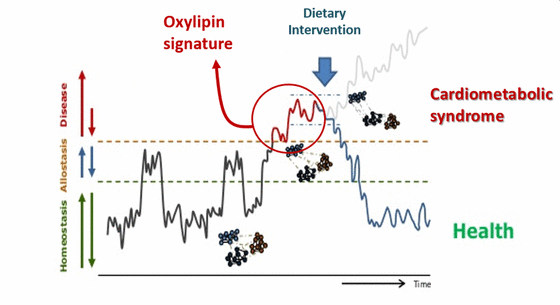
As part of an EU Joint Programming Initiative “A Healthy Diet for a Healthy Life” we are exploring the use of the oxylipin pattern as biomarker for the cardiometabolic syndrome. Based on our internationally validated targeted oxylipin metabolomics methodology (96, 91), sample cohorts in form of cross-sectional and longitudinal clinical studies are analyzed and biomarkers are deduced.
Colorectal Cancer (CRC)
CRC is one of the leading causes of death in the industrialized countries. In our previous work, we could show that the colon oxylipin pattern changes dramatically in response to medication and during the progression of CRC (86, 67).
Current work focuses on the investigation of pre-malignant and malignant lesions in the gastrointestinal tract to evaluate specific lipid mediator signatures of these tissues and correlate the tissue lipidome with blood lipidome. Analysis of tissues and blood samples under the condition of co-medication with acetylsalicylic acid (ASA, aspirin), statins and/or proton pump inhibitor (PPi) will advance/emphasize chemopreventive strategies in the development of gastro intestinal cancer and might contribute to a better understanding of new tumor-preventive strategies
Investigation of a modulation of oxylipin formation by food ingredients
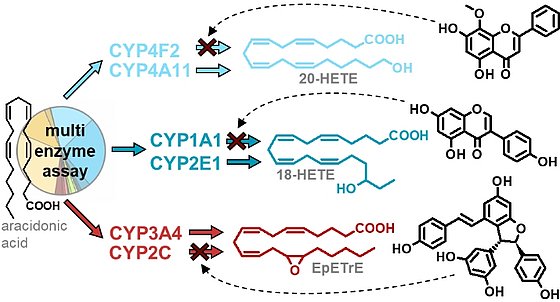
The intake of fruit and vegetables has a positive impact on human health. Secondary plant metabolites such as polyphenols are believed to be responsible for a part of the effects. One molecular mechanism by which polyphenols act is the modulation of the formation of eicosanoids and other oxylipins. Particularly for CYP and 5-LOX inhibition we could show that the potency of several polyphenols is in the low micromolar range (94, 79), a level which may be reached in blood and tissue of human subjects on a polyphenol rich diet.
In order to understand the importance of these effects we use (primary) leukocytes from human blood to study mechanistically the diet derived modulation of the inflammatory response applying both targeted oxylipin metabolomics (83, 75, 64) and quantitative proteomics (98).
Understand the biological role of esterified oxylipins
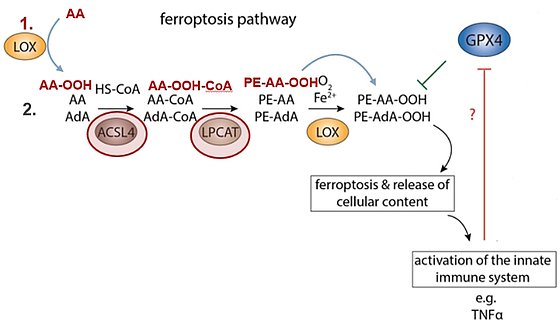
The major share of oxylipins in blood and tissue occurs as esters in polar lipids. However, both their route of formation, as well as their physiological role, is a matter of debate.
In this collaborative project, we will use cells which are transfected with enzymes involved in the formation of (oxidized) phospholipids, apply labelled PUFA and combine this with a comprehensive quantitative targeted lipidomics analysis to investigate the enzymatic pathways of lipid peroxidation during ferroptosis and inflammation.
Understand the beneficial health effect of (omega) n3-PUFA
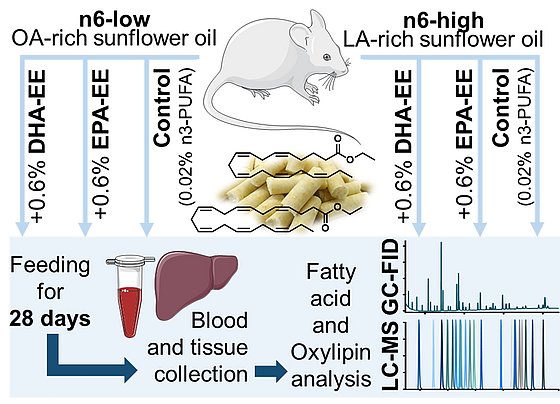
n3-PUFA supplementation is anti-inflammatory in the context of a large number of diseases. In the past decade we comprehensively investigated the n3-PUFA induced changes in the oxylipin pattern in mice (99, 85, 63, 58) and men (72, 68, 66, 65, 61, 59, 52, 33, 32, 30). Most importantly, we could show a linear dose dependency of n3-PUFA intake and the change in specific oxylipins in men (72).
Now, we aim to understand which oxylipins are mediating the health effect of n3-polyunsaturated fatty acids (n3-PUFA). In all biological samples, we could detect the so-called specialized pro-resolving mediators only at very low concentrations (75). Thus, we hypothesize that other oxylipins orchestrate the physiological action of n3-PUFA: Here we focus on the one hand on epoxy-n3-PUFA (93, 45, 23, 14) and on the other hand on oxylipins which we uncovered in a recent study where we found a large number of new oxylipins resulting from multiple lipoxygenase oxidation (95). Ongoing work involves the elucidation of their formation routes, the synthesis of analogs and the activity testing in a battery of cell culture assays.
References: The cited publications can be found in our list of publications.
